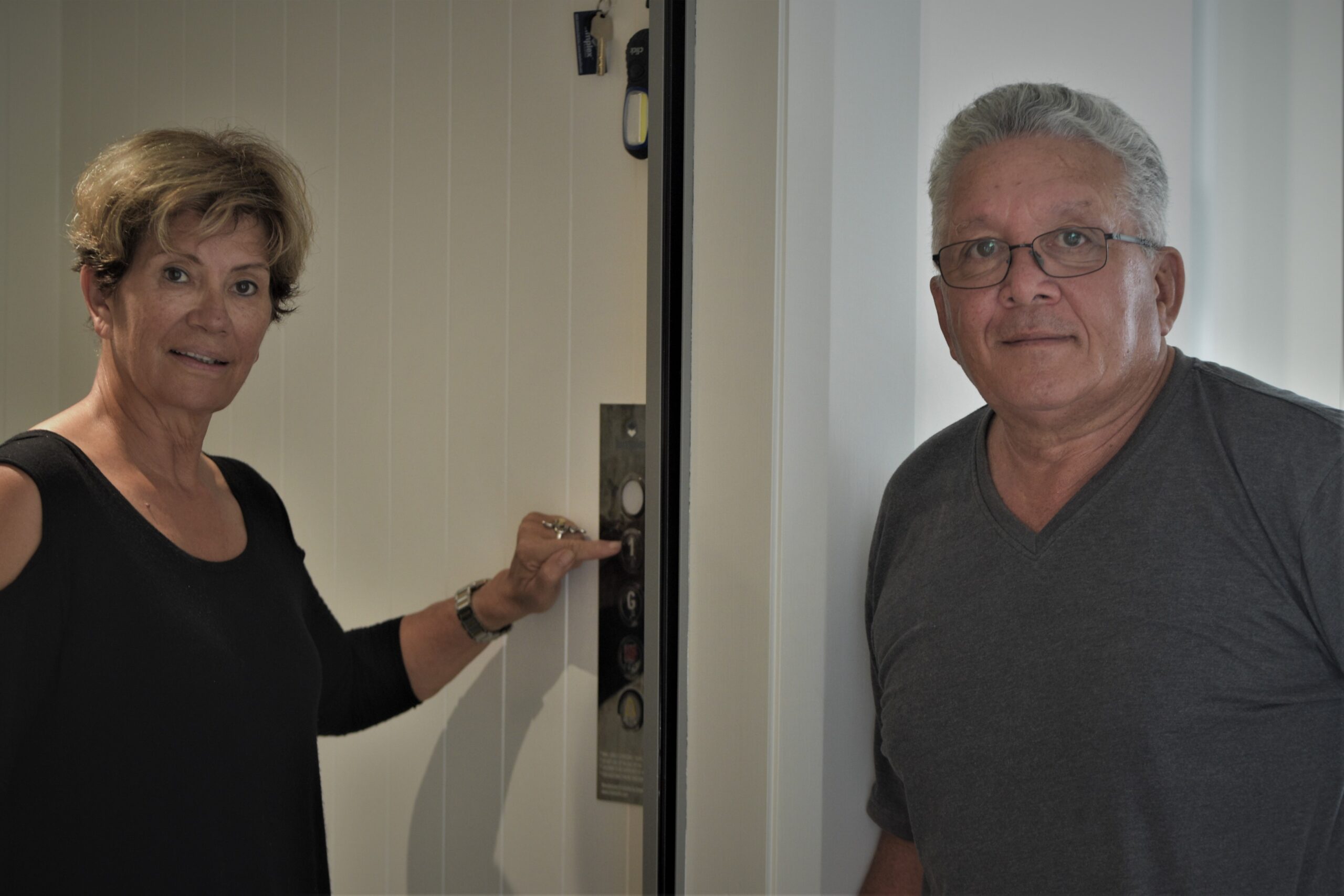The ups and downs of Raro elevators
Tuesday 16 January 2024 | Written by Al Williams | Published in Local, National

Allan and Shar Gray at home on Rarotonga where they have an elevator. Allan uses it as he has limited mobility. PHOTO: AL WILLIAMS 24011503
Rarotonga couple Allan and Shar Gray have jumped aboard the lift in avoiding the ups and downs of traipsing flights of stairs.
They have recently installed an elevator in their new two-storey Black Rock home as Allan has limited mobility from nerve damage below his waistline.
Their daughter-in-law Brooke Gray reckons they have the first passenger lift in the Cook Islands after reading the newly installed $600,000 elevator at the Ministry of Justice building in Avarua was out of action last week.
Cook Islands News checked on the elevator yesterday, it is still out of action, and asked Cook Islands Investment Corporation (CIIC) for an update, as last week the contractor and supplier were “systematically working through thorough diagnostic assessments”.
Meanwhile, Allan and Shar said they opted to have an old school winch system elevator installed at their home, as opposed to the modern hydraulic operating systems, after seeking advice.
“In Fiji, they had a lot of problems.
“One of the companies we went to said they had a lot of problems with the hydraulic systems,” Allan said.
He said air conditioners had to be consequently installed in lift shafts to maintain the temperature of the hydraulic fluid.
“The traditional winch system is more reliable, with less maintenance.”
The couple decided to install the elevator as “future proofing” for Allan who only has 60 per cent use of his legs.
He has recently been diagnosed with lymphoma cancer and has refused conventional treatments.
“I chose to come here (Rarotonga) to try traditional medicine.”
His mobility has been an issue for close to 10 years, having undergone neurological surgeries in an effort to stay out of a wheelchair.
A tiler by trade, Allan picked up his skills on Rarotonga during the mid-80s to mid-90s while dabbling in other ventures including nightclub ownership on the island.
His mother was from Rarotonga and left for New Zealand during the 1950s.
Allan said she brought him and five of his siblings back to the Cook Islands, and always wanted one of them to return.
Allan and Shar made a decision to return to Rarotonga in 2017 and finalised the land in 2019 before Covid-19 hit.
They were still able to get the groundworks done at the Black Rock site and moved on to the site in 2021.
He said the design of their Black Rock home had incorporated an elevator from the start.
It was supplied by a Tauranga based company.
While they had originally opted for a hydraulic elevator, after hearing about the challenges in Fiji, they chose the winch system which was installed in September last year.
He uses it every day, and it has proved a hit with their grandchildren.
It can load up to 500 kilograms and cost about $45,000 including installation. To build the shaft the lift is housed in added another $40,000 to the project, bringing the total cost to about $85,000.
It stretches about seven metres from the base to the roof.
The couple reckon it’s the first passenger lift installed in the Cook Islands.
“If we do have a problem, it’s just a phone call away and our electrician can look at it.”
The Ministry of Justice elevator – the country’s first public passenger lift – was officially opened on November 1 last year.
In November 2021, early consultations concluded that an enclosed passenger lift be constructed at the Ministry of Justice building on Rarotonga, together with appropriate fit-for-purpose toilet facilities.
In February 2022, the ground-breaking ceremony for the construction of the lift was held.
The lift and all the upgrades cost approximately $600,000. New Zealand’s Phoenix Elevators was awarded stages one and two contracts to design and install the lift.
Rarotonga companies AJ Plumbing & Electricals Ltd was sub-contracted to install the associated electrical installations and Landholdings Ltd was engaged to work alongside Phoenix Elevators to construct the lift shaft structure.
Local companies Taio Builders built the new veranda, and Rarotonga Plumbing was contracted for the upgrade of the new toilet facility.
At the elevator’s official opening, CIIC Minister Albert Nicholas said the Ministry of Justice building in Rarotonga had finally addressed major accessibility issues to public services and to the justice system, and accessibility of employment opportunities for persons with disabilities, particularly the infirm, elderly, and disabled.
The problem had existed since the building was completed in 2004 and since then the Government and the wider community, including the Cook Islands National Disability Council, had voiced their concerns about the lack of easy and safe access to the building by its members, Nicholas said at the time.
Cook Islands Disability Council chairperson Tuki Wright, a passionate advocate for easy and safe access to the Justice building, and King’s Representative Sir Tom Marsters were given the privilege to be the first passengers in the lift.
“I am so happy to see this lift finally completed,” Wright said at the opening ceremony of the lift in November. “Today is the biggest day for the people with disabilities of the Cook Islands.”
The Ministry of Justice building elevator stopped functioning just before Christmas, CIIC told Cook Islands News last week.
“We are hopeful that in the next few days, the issue will be diagnosed and the issue remedied,” CIIC said.
The Ministry of Justice building has been plagued with problems over the years. In October 2023, Cook Islands News observed a significant area of the public foyer closed, with multiple buckets spread across the floor.
Late last year, roof waterproofing works, an entrance roof extension and new toilets were completed. The scope of works included cleaning all external windows, doors and skylight sealants and applying new, as well as replacing 3000 rusted screws that contributed to the leaks throughout the building.









































